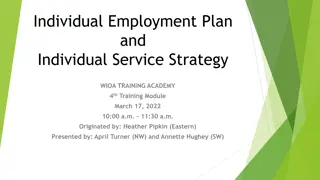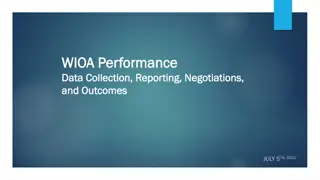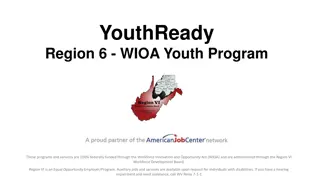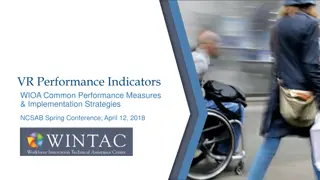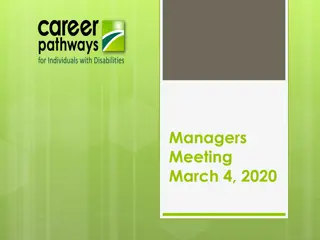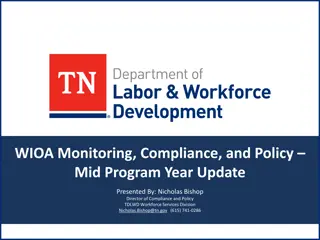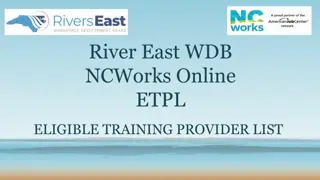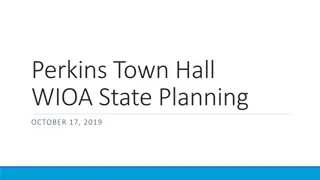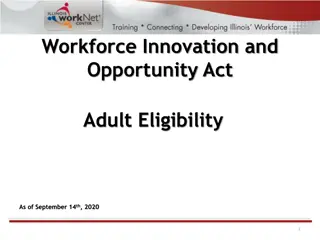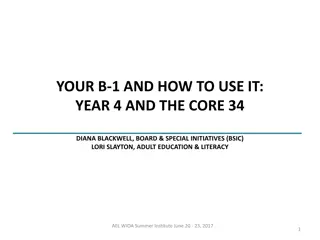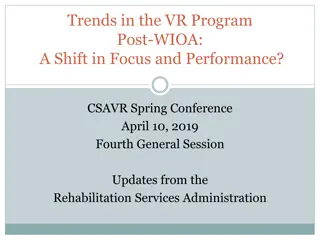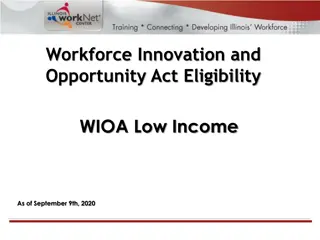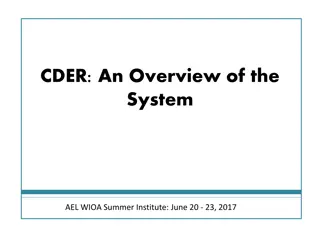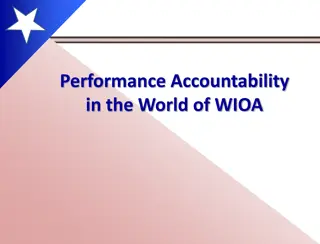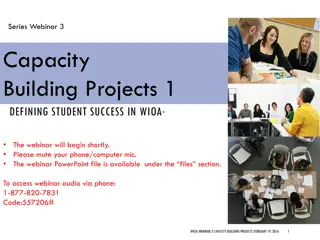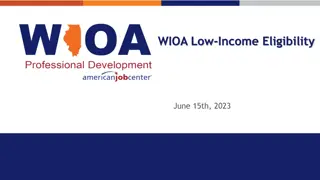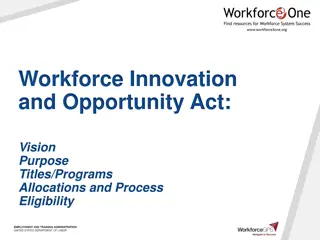
Participant Individual Record Layout (PIRL) for Student Success in WIOA
Explore the significance of the Participant Individual Record Layout (PIRL) for student success in the Workforce Innovation and Opportunity Act (WIOA). Learn about required data elements, reporting essentials, and performance indicators under WIOA for comprehensive program evaluation.
Download Presentation

Please find below an Image/Link to download the presentation.
The content on the website is provided AS IS for your information and personal use only. It may not be sold, licensed, or shared on other websites without obtaining consent from the author. If you encounter any issues during the download, it is possible that the publisher has removed the file from their server.
You are allowed to download the files provided on this website for personal or commercial use, subject to the condition that they are used lawfully. All files are the property of their respective owners.
The content on the website is provided AS IS for your information and personal use only. It may not be sold, licensed, or shared on other websites without obtaining consent from the author.
E N D
Presentation Transcript
Series Webinar 5 Implementing the Participant Individual Record Layout (PIRL) A Quality Model for Student Success DEFINING STUDENT SUCCESS IN WIOA* Carrie Tupa Texas Workforce Commission March 24, 2016 IMPLEMENTING THE PIRL MARCH 24, 2016 1
WIOA UPDATE: IMPLEMENTING THE PARTICIPANT INDIVIDUAL RECORD LAYOUT Carrie Tupa Strategic Planning and Accountability Coordinator Adult Education and Literacy (PIRL) QUALITY MODEL FOR STUDENT SUCCESS IMPLEMENTING THE PIRL MARCH 24, 2016 2
ABOUT THIS WEBINAR What it is What it isn t An introduction to data collection requirements under WIOA Training on how to implement data collection under WIOA The end-all be-all for WIOA data collection and reporting preparation A place to start thinking about a holistic, student success focused, quality intake model IMPLEMENTING THE PIRL MARCH 24, 2016 3
SECTION 1: WHAT IS THE PIRL? IMPLEMENTING THE PIRL MARCH 24, 2016 4
WHAT IS THE PARTICIPANT INDIVIDUAL RECORD LAYOUT (PIRL)? In short, the PIRL are the required elements for reporting under the Workforce Innovation and Opportunity Act (WIOA) The PIRL specifies specific data elements, how those elements are defined and how those elements are reported for all core programs Under WIOA, there is an aligned accountability system across all core programs Title I Adult and Dislocated Worker and Youth Programs Title II Adult Education and Literacy Title III Wagner-Peyser Title IV Vocational Rehabilitation Services IMPLEMENTING THE PIRL MARCH 24, 2016 5
WHAT TYPES OF PERFORMANCE ARE REPORTED UNDER WIOA? In general, WIOA requires that the following indicators of performance be reported: (A) (i) I (I) the percentage of program participants who are in unsubsidized employment during the second quarter after exit from the program (II) the percentage of program participants who are in unsubsidized employment during the fourth quarter after exit from the program (III) the median earnings of program participants who are in unsubsidized employment during the second quarter after exit from the program (IV) the percentage of program participants who obtain a recognized postsecondary credential, or a secondary school diploma or its recognized equivalent (subject to clause (iii)), during participation in or within 1 year after exit from the program (V) the percentage of program participants who, during a program year, are in an education or training program that leads to a recognized postsecondary credential or employment and who are achieving measurable skill gains toward such a credential or employment (VI) the indicators of effectiveness in serving employers established pursuant to clause (iv). IMPLEMENTING THE PIRL MARCH 24, 2016 6
IS REPORTING THE SAME FOR ALL WIOA CORE PROGRAMS? Yes and no WIOA aligns accountability systems, however, individual Federal Agencies may specify unique reporting requirements The Department of Education (ED) outlines requirements specific to Title II in the National Reporting System (NRS) Guidelines NRS Guidelines have been revised, but are not final under WIOA IMPLEMENTING THE PIRL MARCH 24, 2016 7
FROM JOINT REPORTING SUPPORTING STATEMENT SUPPORTING STATEMENT WIOA Annual State Performance Report Template, WIOA Annual Local Area Performance Report Template, WIOA Eligible Training Provider (ETP) Performance Report Template, WIOA Joint Participant Individual Record Layout (PIRL), and WIOA Data Element Specifications OMB CONTROL No. 1205-0NEW The Office of Career, Technical, and Adult Education (OCTAE) will modify its currently-approved information collection instrument, which obtains aggregate data from States using a set of reporting tables developed by The Department of Education (ED) (Implementation Guidelines: Measures and Methods for the National Reporting System for Adult Education, OMB Control No. 1830-0027). For the purposes of the Adult Education and Family Literacy Act (AEFLA) program, States will be required to complete and submit the WIOA Annual State Performance Report template, in addition to the aggregate data tables that States are required to submit to OCTAE under OMB Control No. 1830-0027 Full statement available here: https://www.doleta.gov/performance/pdf/Federal%20Register%20- %20Joint%20Performance%20ICR%20Supporting%20Statement.pdf IMPLEMENTING THE PIRL MARCH 24, 2016 8
HOW IS PIRL DATA USED? Basic understanding of service delivery and participant characteristics PIRL data affects targets As part of the performance accountability requirements, WIOA requires the use of a statistical adjustment model for setting targets for the core performance indicators Factor data collected in the PIRL directly affects our statewide targets IMPLEMENTING THE PIRL MARCH 24, 2016 9
STATISTICAL ADJUSTMENT MODEL Model based on differences in economic conditions and characteristics of participants, including: Indicators of poor work history Low levels of literacy Low levels of English proficiency Lack of educational or occupational skills attainment Disability status Homelessness Ex-offender status Welfare dependency Barriers to employment (including cultural) Dislocation from high-wage and high-benefit employment IMPLEMENTING THE PIRL MARCH 24, 2016 10
SECTION 2: HOW IS THE PIRL DIFFERENT ? IMPLEMENTING THE PIRL MARCH 24, 2016 11
EXAMPLE IMPLEMENTING THE PIRL MARCH 24, 2016 12
EXAMPLE(2) According to the PIRL Record 1 if the participant indicates that he/she has any "disability , as defined in Section 3(2)(a) of the Americans with Disabilities Act of 1990 (42 U.S.C. 12102). Under that definition, a "disability" is a physical or mental impairment that substantially limits one or more of the person's major life activities. Record 0 if the participant indicates that he/she does not have a disability that meets the definition. Record 9 if the participant does not wish to disclose his/her disability status. IMPLEMENTING THE PIRL MARCH 24, 2016 13
QUALITY MODEL FOR STUDENT SUCCESS As part of data collection, programs: Must make time to ask each of the PIRL fields as a question Must make time to clarify each response This means a need for a holistic, student success-focused, intake model IMPLEMENTING THE PIRL MARCH 24, 2016 14
NEW TEAMS IMPLEMENTING THE PIRL MARCH 24, 2016 15
WHAT IS MEANT BY QUALITY INTAKE FOR STUDENT SUCCESS More akin to intake done for other workforce programs In workforce, model is used to determine eligibility for various services, but also to assist in making referrals WIOA performance metrics require ongoing monitoring of participant activities and performance past achievement of the high school equivalency Must ensure route to success in entering and completing postsecondary education/training and/or employment! IMPLEMENTING THE PIRL MARCH 24, 2016 16
WHAT YOU TOLD US Size of your largest registration event >25 Number of Students 25-50 50-100 100-150 150+ Unknown 0% 5% 10% 15% 20% 25% IMPLEMENTING THE PIRL MARCH 24, 2016 17
WHAT YOU TOLD US(2) Which of the following activities do you include as part of your registration/intake process? 0% 50% 100% Registration or Placement 90.48% Class selection 59.52% One-on-one Interview (NOT BEST 54.76% Review of policies/procedures 78.58% Test administration 85.71% Intake/registration form completion 88.10% Goal setting 64.29% Learning style inventory 26.19% Study or other success skills 21.43% Academic skills review 23.81% Career inventory 19.05% Other (please specify) 28.57% IMPLEMENTING THE PIRL MARCH 24, 2016 18
WHAT ARE THE DATA FIELDS? IMPLEMENTING THE PIRL MARCH 24, 2016 19
PIRL DATA FIELDS What we know What we don t know.. Draft regulations for the PIRL have been published What the final regulations are What the final regulations will say about data collection for AEL Final regulations are scheduled to come out sometime this summer How the PIRL will be tied into the NRS Intake for AEL will need to be adapted (to what extent we don t yet know!) How best to collect/when to collect the information during peak enrollment periods IMPLEMENTING THE PIRL MARCH 24, 2016 20
DRAFT REGULATIONS FOR PIRL HAVE BEEN PUBLISHED Official draft version of the PIRL can be found here: https://www.doleta.gov/performance/pdf/WIOA_PIRL.pdf We have a draft information sheet for AEL providers; we will provide information how to access it at the end of this webinar. IMPLEMENTING THE PIRL MARCH 24, 2016 21
FINAL REGULATIONS ARE SCHEDULED TO COME OUT THIS SUMMER We ve begun changes in TEAMS scheduled to be released 6/23/16 based on draft regulations AEL grant recipients need to plan to have a modified intake process beginning 7/1/16 IMPLEMENTING THE PIRL MARCH 24, 2016 22
AEL INTAKE WILL NEED TO BE ADAPTED We will share the draft regulations, but you should not begin printing materials until final regulations have been approved AEL Student Success Quality model road show will be coming to a city near you in May June We will release locations in the next week These sessions will be focused on how to conduct intake, how to design a student success quality intake model, and how to use the information gathered to improve participant success and retention You can attend any session that is convenient for you IMPLEMENTING THE PIRL MARCH 24, 2016 23
AEL QUALITY MODEL FOR STUDENT SUCCESS ROAD SHOW IMPLEMENTING THE PIRL MARCH 24, 2016 24
WHO SHOULD ATTEND? Directors, supervisors, and any staff involved in participant intake/registration Partner staff involved in participant intake/registration Board partners IMPLEMENTING THE PIRL MARCH 24, 2016 25
WHAT WILL BE COVERED? Up-to-date information on required data collection Best-practices in intake Ideas for incorporating detailed intake into your registration process Ways to ask questions to collect required information Time to plan/discuss/prepare for implementing a quality model in your program Changes to the AEL assessment guide to address WIOA Requirements around protecting Personally Identifiable Information (PII) IMPLEMENTING THE PIRL MARCH 24, 2016 26
FOLLOW-UP DOCUMENTS AND NEXT STEPS 1) Complete the follow-up survey located at: https://www.surveymonkey.com/r/AELPIRL 2) We will send you the draft AEL PIRL fields and a questionnaire to help you prepare for the road-show events IMPLEMENTING THE PIRL MARCH 24, 2016 27
QUESTIONS? Please use the survey for this webinar to submit questions so that we can respond with a Q&A to all participants. https://www.surveymonkey.com/r/AELPIRL IMPLEMENTING THE PIRL MARCH 24, 2016 28

